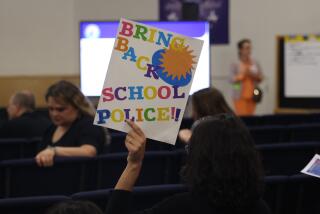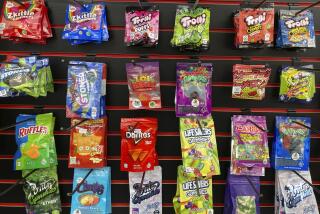U.S. teens are taking fewer risks with their health, though drinking and unsafe sex are still common

- Share via
The school year is over, and public health officials have issued a report card for America’s high school students.
On the whole, the marks are good. Fewer U.S. teens are having sex or using illicit drugs. (There’s no mention of rock-and-roll.) They’re also less likely to drink and drive, smoke cigarettes or drink alcohol on a regular basis.
“The overall prevalence of most health-risk behaviors has moved in the desired direction,” wrote a team from the Centers for Disease Control and Prevention’s Division of Adolescent and School Health.
However, they added, “many high school students are engaged in health-risk behaviors associated with the leading causes of death” for their age group.
The assessment is based on data from the 2017 National Youth Risk Behavior Survey. The CDC conducts the survey every other year with a randomly selected, nationally representative group of students in grades 9 through 12. The students, from both public and private schools, answered up to 99 questions covering a wide range of topics. A total of 14,765 questionnaires were used to compile this report.
Here’s a look at the report card, which appears in Friday’s edition of the CDC’s Morbidity and Mortality Weekly Report.
Sexual behavior
Just under 4 in 10 high school students said they have had sexual intercourse at least once, with boys (41%) slightly more likely than girls (38%) to have lost their virginity. The overall figure was essentially unchanged from the last survey in 2015, but was significantly lower than the 54% of students who reported having had sex when the survey was conducted in 1991.
Nearly 30% of students said they had been sexually active in the previous three months, and 10% had slept with four or more people. Back in 1991, 19% of students said they had had four or more sexual partners.
Among students who were currently sexually active, 29% said either they or their partner used some type of long-acting, reversible birth control, such as an IUD, implant or birth control pills. Only 54% said a condom was involved the last time they had sex. In 2005, that figure was 63%.
Sexual assault
About 7% of students said they had been forced to have sex against their will, with girls (11%) far more likely to have experienced this than boys (4%). An even greater disparity was seen based on sexual orientation, with 5% of heterosexual students and 22% of gay, lesbian and bisexual students saying they were forced to have sex when they didn’t want to.
Nearly 70% of high schoolers said they had dated someone in the previous year, and among these students, 7% reported that during that time, they were forced to do “sexual things” that they didn’t want to do, such as kissing, touching or having intercourse. That’s down from 2015, when nearly 11% of students reported instances of “sexual dating violence.”
Smoking
Nationwide, 29% of students said they taken at least one puff from a cigarette at some point in their lives, and 9% smoked at least once during the previous 30 days, including the 2% who smoked on a daily basis. All of these figures were down sharply from 1991, when 70% of students said they had tried at least one cigarette, 28% said they had smoked in the past month and 10% smoked every day.
The story was different for electronic cigarettes. According to the survey results, 42% of high school students had tried some sort of vaping product at least once, and 13% had vaped in the previous 30 days — significantly lower than the 24% who were current vapers in 2015. In 2017, boys (16%) were more likely than girls (11%) to say they had vaped recently, and 3% of students overall vaped frequently (on at least 20 of the previous 30 days).
Drug use
Marijuana was the most popular drug among high schoolers, with 36% of students saying they had used it at least once and 20% using it in the 30 days before they took the survey. Both of these figures are down from their peaks in the mid- to late-90s, when 47% of students had tried pot and 25% had used it recently.
In 2017, black (43%) and Latino (also 43%) students were more likely than white students (32%) to have tried pot.
Also in 2017, 5% of high schoolers said they had tried some form of cocaine, 2% had tried heroin, 3% had used methamphetamines, 4% had taken Ecstasy and 7% had tried hallucinogenic drugs like LSD or magic mushrooms. All of these figures are down from their highs in 1999 or 2001.
Painkiller abuse
About 1 in 7 students said they had taken a prescription painkiller without a prescription or in a way that was not directed by a doctor. These painkillers included OxyContin, Vicodin, Hydrocodone, Percocet and codeine.
Prescription painkiller abuse was as low as 8% in some states and as high as 19% in others. This was the first time students had been asked about these drugs, so there were no comparisons to previous years.
Alcohol use
Well over half — 60% — of students had taken a drink of alcohol at least once in their lives. Girls (63%) more likely than boys (58%) to have tried it, as were Latino (65%) and white (62%) students compared with black students (51%). In 1991, 82% of students had tried drinking at least once.
Current drinking — that is, consuming alcohol at least once in the previous 30 days — was also down from historical highs, falling from 51% in 1991 to 30% in 2017.
Nearly 14% of students had a recent episode of binge drinking, defined as consuming at least four drinks in a row for girls or at least five in a row for boys. This was the first time the survey asked about binge drinking, so there were no historical comparisons.
Risky driving
Nearly 63% of students who took the survey could drive; among them, 6% said they had drunk alcohol and 13% said they had used marijuana before getting behind the wheel at least once in the previous 30 days. Boys (6.8%) were more likely than girls (4.1%) to drive after drinking. As recently as 2013, 10% of high school drivers said they had recently operated a vehicle after drinking.
About 1 in 6 students said they had been a passenger in a car driven by someone who had been drinking at least once in the previous 30 days. That’s an improvement since 2015, when 1 in 5 students had ridden with a driver who had been drinking. In 1991, 2 out of 5 students had done so.
Among the students who could drive, 39% said that they had recently texted or used their email while they were behind the wheel. This figure is essentially unchanged from the 41% who texted or emailed while driving in 2013.
Nearly 6% of high schoolers said they “rarely” or “never” wore a seat belt when they were passengers in a car, with boys (6.6%) more likely to do this than girls (5.1%). It used to be a lot more common — in 1991, nearly 26% of high schoolers failed to buckle up on a regular basis.
Follow me on Twitter @LATkarenkaplan and “like” Los Angeles Times Science & Health on Facebook.
MORE IN SCIENCE
NASA engineers hope the Opportunity rover will sleep through a continent-sized dust storm on Mars
Antarctica’s ice is shrinking at an unprecedented rate that could imperil coastal regions worldwide
Are prescription medications making Americans depressed?







